AUTODROMO DI MONZA (I)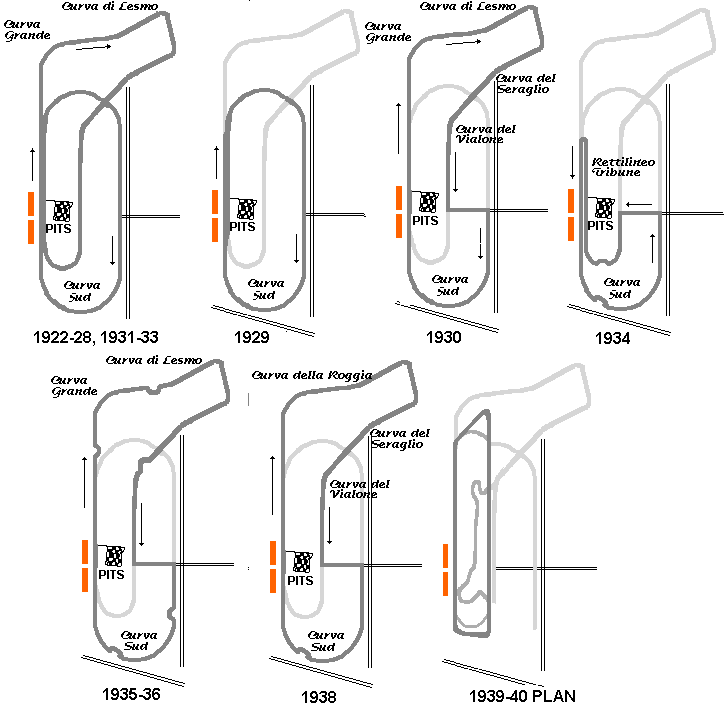
Type: Autodrome + Speed oval Length: 10.000 km (Italian GP 1922-28, 1931-33, Monza GP 1931-33) 4.500 km (Monza GP 1929) 6.680 km (Monza GP 1930) 4.310 km (Italian GP 1934) 6.890 km (Italian GP 1935 & 1936) 6.993 km (Italian GP & Milan GP 1938) Location: North of the city of Milano, north-west Italy Used: 1922 - Monza is THE classic Grand Prix circuit! The first Italian GP was run in 1921 at Montichiari near Brescia. The next year the Milano Automobile Club decided to build a permanent race circuit to celebrate the 25th anniversary of the club. As the circuit also should serve the Italian automobile industry as a test circuit it was necessary to have road sections that permitted high speed running as well as sections that put steering and mechanical parts to test. After having considered several places near Milan including Parco Sempione and Via Gallarate the wooded royal park in Monza was finally selected. Founded in 1805 the royal park had witnessed the assassination of the King of Italy, Umberto I, by an anarchist in 1900. The Italian royalties did not want to have anything to do with the royal park any longer and it had been neglected for 20 years. The park was chosen as it was large (the fourth largest closed park in Europe) and was ideally positioned near Milan with good communications. The Board Chairman of the club, senator Silvio Crespi, and director Arturo Mercanti, assigned architect Alfredo Rosselli to build a 14 km autodrome in the park, the third of its kind after Brooklands (1907) and Indianapolis (1909). A company, S.I.A.S (Società Incremento Automobilismo e Sport), was founded to pay the 6 million liras needed for building the circuit with private capital. The first stone was laid by drivers Vincenzo Lancia and Felice Nazzaro at the end of February, 1922, but only a few days later work was suspended and new plans were made up for a smaller size circuit that would have less impact on the monumental value of the park. Work started anew on 15 May and only 74 days later, on 28 July, Petro Bordino and Felice Nazzaro made the first test run on the track. The circuit was officially opened 111 days after work had started on a rainy 3 September, when 100,000 spectators saw Pietro Bordino take the victory in a voiturette race. One week later Bordino won the second Italian Grand Prix on the circuit. Monza has, with four exceptions (1937, 1947-1948, 1980), continued to hold the Italian Grand Prix into the 21th century. In its original form Monza consisted of two parts: a 4.5 km speed loop with a track width of 12 m that consisted of two 1070 m long straights and two banked curves with 320 m radius rising 2.6 meter (~ 12°) above the ground, and a 5.5 km long road track, similar to the one that still exists. Used together they created a 10 km long race track. On the road track, the 9 m wide main straight led into the right hand Curva Grande with a radius of 303.4 m. The road narrowed to 7.5 m before the left handed Curva della Roggia (170 m radius) and widened again to 9.1 m for the two Lesmo curves with 98 and 100 m radius. The fast slight left handed Curva de Serraglia (radius 599 m) led the track under the speed loop on to Curva de Vialone, a 227 m radius left hander that was followed by the long straight that led to the last curve, the 180 degree Curva Sud with a 12 m track width and a 152.55 m radius, that took the cars back to the start and finish line. The straights were surfaced with tarred macadam while the curves were surfaced with tarred concrete. The full 10 km lap started next to the grandstand, the cars did the road circuit and came back to the finish but on the pits side, then continued into the oval, first the wide North Turn, then the wide South Turn and back to the finish but now again on the grandstand side where the time keepers were counting the laps. Opposite the pits was the main grandstand that held 3000 spectators and also a further six stands for 1000 spectators each. There were also open stands outside the speed loop curves, the south curve, and where the two tracks met. From the beginning Monza had its fair share of fatal accidents. Among the better known, Ugo Sivocci crashed while testing the new Alfa Romeo P1 in 1923 and Count Louis Zborowski of "Chitty Bang Bang" fame died in an ill handling works Mercedes in 1924. The worst accident in the history of Grand Prix racing happened in the 1928 European Grand Prix when Emilio Materassi lost control of his Talbot when lapping a backmarker and crashed into the grandstand killing himself and twenty-seven spectators. No Italian Grand Prix was held in 1929 and 1930. Instead the president of the Automobile Sports Commission, Vincenzo Florio, organized a Monza Grand Prix with heats and final on the speed oval in 1929. In 1930 he introduced the 6,680 m track combination that would be called the "Florio circuit" after him (see map). The next three years the Italian Grand Prix was run on the original 10 km combination. The 1933 Monza Grand Prix run on the speed oval will always be remembered as the "Black Day of Monza" as it claimed the lives of Giuseppe Campari, Mario-Umberto Borzacchini and Count Stanislas Czaykowski. For 1934 a slow track variant with a U-curve and two chicanes was selected for safety reasons. The next two years the Italian Grand Prix was raced on the "Florio circuit" with four straw-bale chicanes added in an unsuccessful attempt to slow down the faster German cars. Back then Monza was much used for pre-season testing. During such a test in 1936 Auto Union driver Rudolf Heydel had a fatal crash. For 1937 the Grand Prix was moved to the slower Livorno track but next year it was back to Monza, this time using two chicanes on the "Florio circuit". After the 1938 race work began on an extensive rebuilding of the track including road resurfacing, pulling down the banked curves on the speed track, construction of a new 2,000 seat main grandstand in concrete and 30 pits built of masonry , adding a new entrance and construction of several other buildings. The backstretch was moved westwards and was connected to the main straight with two 90 degree bends with 60m radius known as the Curva Sud or Curve del porfido because of their stone paving. (Track length: 6300m) During the war Monza, as many other race tracks, was used for various purposes that had nothing to do with racing, but in 1948 the track was restored in less than two months and on 17 October the Autodrome Grand Prix was held on the track. The Italian Grand Prix was back the next year. In 1954 work was started to rebuild the circuit. A new 4.250 km high-speed oval was built with a 30° banking that increased progressively towards the top. The main straights were shortened and the Curva Sud was replaced with the Parabolica (Track length 5750 m). The speed oval came in disuse in the late 1960s. In 1972 two chicanes were added, one on the main straight and one at Vialone (Variante Ascari). Track length: 5775 m. The Vialoni chicane was eased in 1974 (5780 m) and in 1976 a third chicane was added at the entrance of the first Lesmo (Variante Roggia) when the main straight chicane was also rebuilt (5800 m). 1989-1990 the track got a new pit building with 48 boxes. In 1995 Curva Grande, Variante Roggia and the Lesmo curves were moved back to increase the safety zones (5770 m). In 2000 the main straight chicane was rebuilt and 10 m was added to Variante Roggia (5793 m). In 2001 the pit building was lengthened to 60 pit boxes . The Monza post war Grand Prix history is as bloody as its pre war history. Alberto Ascari crashed fatally during a private test run in 1955. "Taffy" von Trips and 14 spectators died after a crash between von Trips and Jim Clark on lap two of the 1961 Grand Prix. Jochen Rindt had a fatal crash when trying to race the Lotus 72 without wings during qualifying for the 1970 Grand Prix and Ronnie Peterson succumbed to his injuries after a multiple crash in the 1978 Grand Prix. 1922 GRAN PREMIO D'ITALIAFor the Italian GP see also Brescia and Livorno MONTENERO-Livorno (I)
Type: Road course Length: 20.1 km/22.5 km Location: In the city of Livorno (Leghorn), Tuscany, Italy, and on the roads south of the city. Used: 1921-1935 The city of Livorno was founded in 1017 as a coustal fortresses to protect Pisa. The idea to create a race course on the roads near the city to bring fame and tourism to the area was proposed in spring 1921 by Paolo Fabbrini, owner of the newspaper Corriere di Livorno. The idea was received by great enthusiasm and a committee was created to take care of the organization. The course got its name from the mountain Monte Nero, south of the city. The first Coppa Montenero was raced on September the same year and proved to be a huge success. For the next year the course layout was modified. A 22.5 km route was selected that took the cars up the mountains on a very long and hard course with narrow winding roads. 1927 The Minister of Posts and Communications, and President of the Chamber of Deputies, Costanzo Ciano, whose son later was to to become Benito Mussolini's son-in-law, donated a trophy for the event and from 1927 to 1939 the competition was known as the Coppa Ciano . After having been a local Italian affair in the 1920s the race became a part of the international GP calendar in the 1930s. The course had narrow roads, dangerous sections and lots of stone walls. It was therefore also slow and very unpopular by the drives. The course circled the Rotonda d'Ardenza and passed along the narrow streets of the Ardenza district of Livorno. Then it turned right and passed under the railroad before leaving the city, passing Villa St. Georgio, and starting to climb in long sweeps upwards towards Montenero. Leaving Via di Montenero for Via del Castellagio the road got steeper and narrower, climbing 100 m in serpentine curves, and then yet another 100 m before reaching the village of Castellagio at Monte Nero, 300 meters above sea level. There the road started to go downwards, first through the village and then over open terrain to a hairpin near Evangelisti. That curve would later be named after Tazio Nuvolari. A new sweeping section through woods and over open terrain with some great views followed by a new series of serpentines that led the course down to Romito and the coast where it joined the old Roman road Via Aurelia (originally built 241 BC!) The route continued along the coast back towards Livorno, passing Calafuria and Castel Boccale and doing a side trip through the narrow streets of Antignano before returning to the city and Rotonda d'Ardenza. For the 1936 race, for safety reasons, the Montenero mountain section was removed. Two drives dominated the event. Materassi was a four time winner in the 1920s and then Nuvolari won five times in the 1930s (icluding one victory on the shorter track). See also Livorno. 1922 COPPA MONTENERO LIVORNO (I)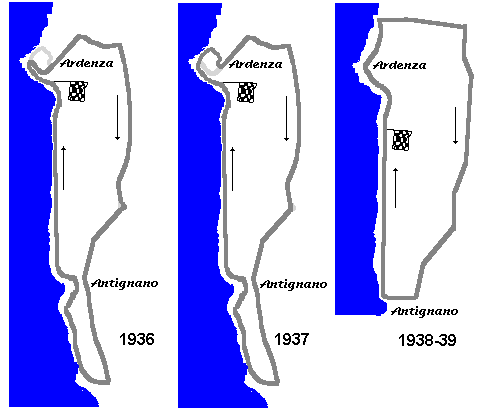
Type: Road course Length: 7.218 km /5.80 km (1938) Location: In the city of Livorno (Leghorn), Tuscany, Italy, and on the roads south of the city. Used: 1936-39, 1947-53 For the 1936 Coppa Ciano race, for safety reasons, the Montenero mountain section of the course (See Montenero track) was removed. On this course variant, rather than circling the rotunda the cars went through a hairpin and returned back on the west side before moving left and into the Ardenza district. Instead of climbing along Via di Montenero the route took the cars along the railroad before passing over it on the way through Antignano along the main street. South of Antignano after a sharp turn it joined the old race track back towards Livorno. That left a track length of 7.218 km and it was also the track configuration used when the track hosted the 1937 Italian Grand Prix, probably in attempt to give the Italian cars a better chance against the German cars than on the fast Monza track. In 1938 the track was shortened again to 5.8 km. The last 5.8 km variant skipped the south part of Antignano, instead crossing the district from east to west along Via dei Bagni. The last Coppa Ciano before the Second World War was held in July 1939, Costanzo Ciano having died a few weeks earlier. That race, like many other Italian events in the late 1930s was run to the voiturette formula. In 1947 an attempt was made to resurrect the Montenero Circuit but the race was not a financial success. After a minor race in 1953 the track was closed down. 1936 COPPA CIANO CIRCUITO DI MONTICIARI, BRESCIA (I)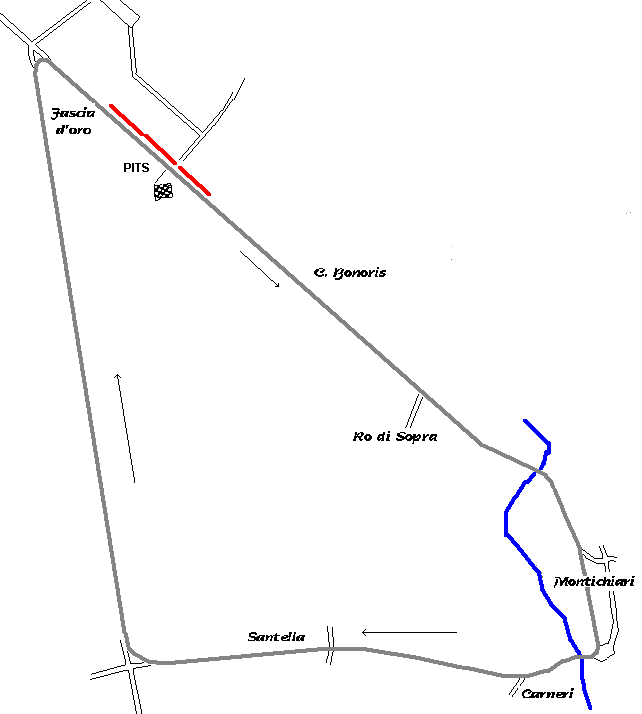
Type: Road circuit Length: 17.3 km Location: Southeast of Brescia, Lombardy, Northern Italy. Used: 1921 The Brescia races dated back to September 1907, when Minoia won the Coppa Florio with Isotta-Fraschini and Cagno came first in the Coppa di Velocità driving an Itala. Both were passing through Montichiari on a 60.745 km circuit, which was shortened for 1921. The new Montichiari Circuit was only 17.3 km long on flat terrain just south-east of Brescia in the flatland of Montichiari. The triangular shaped course had the start near the beginning of a 6 km straight, heading south, with three stands on the east side and pits opposite with start and finish, from where the drivers darted along the straight in clockwise direction. At its end a new 1.3 km large avenue was built to bypass Montichiari. Here the circuit tuned right and snaked along a 4.2 km road past Carneri and Santella. At its end were the crossroads of Ghedi with a new wide right turn leading north along the 5.4 km straight which ended at Fascia d'Oro. There it headed east along the newly built 423-meter long Parabolica turn, connecting with the other straight leading now south. About 1 km further on was the finish. The racetrack was between eight and ten meter wide, covered with macadam and spread with tar to avoid dust development. Additionally, stands were installed, also a King's tent, restaurants, car parks, cabins for officials and timekeepers, a press stand, telegraph and telephone office, also on various parts of the circuit. The restoration work had cost more than 1.5 million lire. Five engineers and more than 1000 workers with 12 motorized rollers and the same amount of water sprayers had been busy. 1921 GRAN PREMIO D'ITALIA PESCARA (I)
Type: Road course Length: 25.80 km ? (25.579 km?) Location: On the east coast of Italy, some 100 km east of Rome. Used: 1924 - 1961 The start was at Castellammare, north of the seaside resort of Pescara, where the road went straight for about one kilometer along the shore of the Adriatic Sea. Before Pescara the course made a wide right turn heading inland for about 11 km along a winding uphill road into the Abruzzi Mountains through the villages of Villa Raspa, Spoltore and Capelle. From here, the road led into the approximately 11 km long Montesilvano downhill straight to the coast where cars could reach their maximum speed. A right turn at Montesilvano railroad station led into the Lungo Mare straight along the coast and back to the start and finish at Castellammare. 1924 COPPA ACERBO GRANDE CIRCUITO DELLE MADONIE - Palermo (I)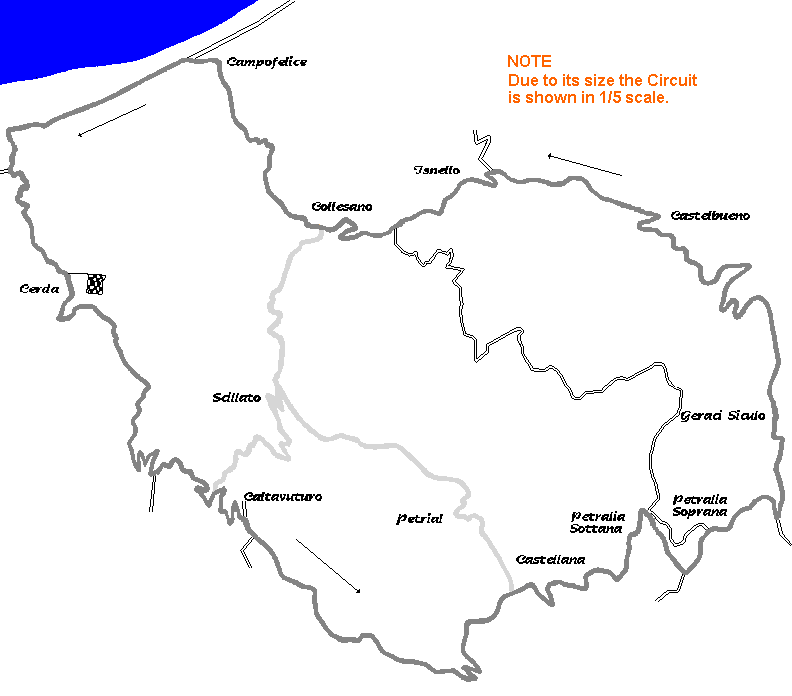
Type: Road course Length: 148,823 km (original), 146,0 km (1931) Location: Northern Sicily, some 30-50 km east of Palermo Used: 1906-1911, 1931 The Grand Circuit was used from 1906 until 1911. In February 1931 a cyclone in northern Sicily had caused large floods, destroying long stretches of the 108 km Medium Madonie Circuit. The only possible way out was to settle on the longer and more difficult 146 km circuit for the 1931 event. The Grand Circuit branched off over Petralia Sottana, Geraci and Castelbuono and returned again over Collessano and Campofelice to the Medium circuit. Only 13 cars arrived at the start. Rain had started on lap two and after three laps torrential downpours turned some of the mountain roads into mud pools. he event proved to be a great success for Alfa Romeo with Nuvolari winning followed by Borzacchini. 1931 TARGA FLORIO MEDIO CIRCUITO DELLE MADONIE (I)
Type: Road course Length: 108 km Used: 1919-1930 1921 TARGA FLORIO PICCOLO CIRCUITO DELLE MADONIE (I)
Type: Road course Length: 72 km Used: 1932-1936, 1951-1977 1932 TARGA FLORIOSee also Favorita park FAVORITA PARK - Palermo (I)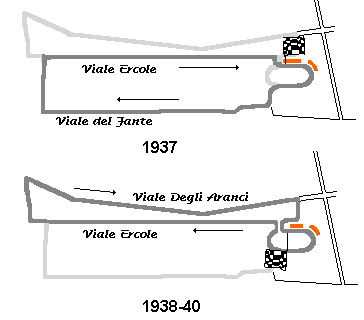
Type: Park circuit Length: 1937: 5.26 km (3.27 mi) 1938-40: 5.718 km (3.55 mi) Location: Parco Della Favorita, 1 km north of central Palermo, Sicily. Used: 1937- 1940 1937 TARGA FLORIO (Voiturette)See also Circuito Delle Madione CIRCUITO DI ALESSÁNDRIA - Alessandria-Valenca-Castelletto (I)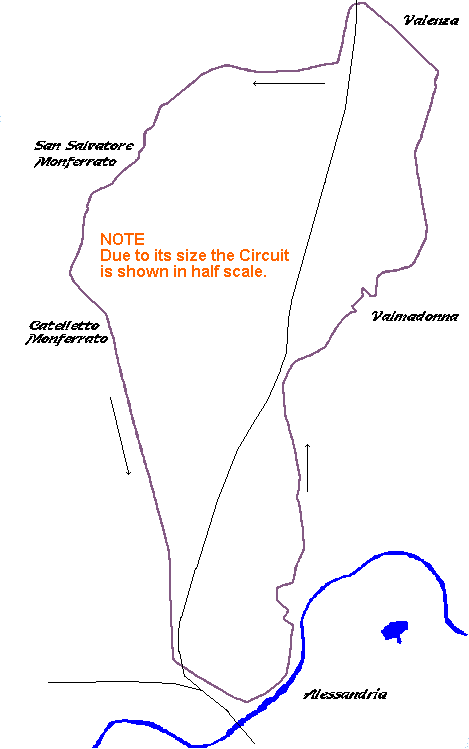
Type: Road Course Length: 32 km Location: Alessandria - Valenza Po - San Salvatore - Castelletto - Alessandria Used: 1925 CIRCUITO DI ALESSÁNDRIA CIRCUITO DI PIETRO BORDINO - Alessándria (I)
Type: Road course Length: 8 km Location: Near the city of Alessándria, between Torino and Milano, northwest Italy Used: 1931 CIRCUITO DI PIETRO BORDINO BERGAMO (I)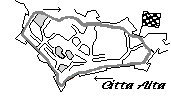
Type: Street circuit Length: 2.92 km Location: In the town of Bergamo, 40 km north-east of Milano. Used: 1935 Track description: Piazza S. Agostino - porta S. Agostino - porta S. Giacomo - Colle Aperto - la Boccola - mura della Fara - Piazza S Agostino. 1935 COPPA CITTA DI BERGAMO CIRCUITO DE BIELLA (I)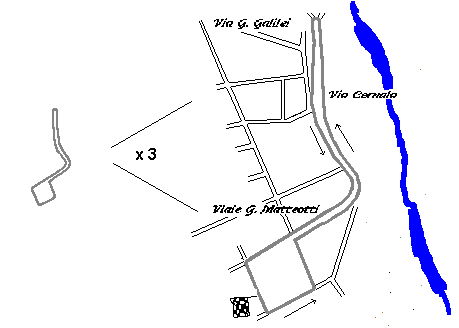
Type: Street Circuit Length: 2.216 km Location: City of Biella, Piemonte, 80 km north-east of Torino (Turin). Used: 1934-35 Track description: Start on Piazza Vittorio Veneto, Via Antonio Bertodano,Via della Repubblica, 12m downhill on Via Cernaia, turn to north and following Via Cernaia to the hairpin at Via Milano corner, 12 m uphill on on Via Gugliemio Marconi, Viale Giosué Carducci, Viale Giocomo Matteotti, back to Piazza Vittorio Veneto. (Note, modern street names, some of them have probably been changed since the 1930s) 1934 CIRCUITO DI BIELLA CIRCUITO DI BOLOGNA (I)
Type: Street/Park Circuit Length: 4.8 km Location: Margherita gardens, just south of Bologna town center Used: 1927 The start was inside the park at piazzale giardini Margherita then went clockwise along viale Regina, a right turn onto viale Margherita, followed by a long left turn onto via Castiglione, next a right turn onto via Cappucini, another right onto via Panoramica with a left-right along via S. Mamolo and another right turn onto the long straight of viale Panzacchi changing name to viale Gozzadini, followed by a sharp right turn into viale Giardini, next two left turns with the final right turn just before the finish at piazzale giardini Margherita. 1927 CIRCUITO DI BOLOGNA CIRCUITO LIGURE-PIEMONTESE (I)
Type: Road Course Length: 45 km (27.96 mi) Location: Near Novi Ligure, Piedmont. Some 30 km north of Genua. Used: 1926 The road circuit was located in the Piedmont region of the Alessandria province in the Po valley. The circuit was triangular in shape and was perfectly flat. It ran clockwise with the start in the city of Novi Ligure on the Corso Romualdo Marenco, from which it turned right at the station square through a narrow curve in front of the Grand Hotel, which was protected by sandbags. From there, the circuit proceeded along Via Mazzini, exiting the town to head north through nearby Pozzolo Formigaro, where a fast right turn was followed by a straight stretch of 14 km to the very old town of Tortona (east of Alessandria). Here the course made two right turns, one into the town, the other exiting it to head south along another straight stretch of 20 km past Porta Alessandria. This was followed by Corso Genova, then Serravalle, passing through the villages of Villavernia and Cassano Spinola, and eventually reaching the turning point of Serravalla Scrivia. At Serravalle there was a hairpin, which was considered the most dangerous bend of the circuit. The course then led north along a more or less straight stretch of about 7 km of Route Nationale No.35 back to Novi at the start and finish. 1926 CIRCUITO LIGURE-PIEMONTESE CAMAIORE (I)
Type: Length: 27.3 km (17.0 mi) Location: Camaiore, near Lucca, Tuscany Used: 1929 COPPA DI CAMAIORE CIRCUITO DI CAMPIONE D'ITALIA (I)
Type: Street Circuit Length: 1.116 km (0.693 mi) Location: On the streets of Campione D'Italia, an Italian exclave within Switzerland. Used: 1937, 1946 1937 CIRCUIT OF CAMPIONE D'ITALIA (Voiturette) CIRCUIT OF CARNARO - Abbazia (I)
Type: Road course Length: 6km Location: Preluk, between Rijeka (Fiume) and Opatija in Croatia. Used: 1939 Satellite picture indicate track length probably closer to 5.5 km than 6 km. 1939 CIRCUIT OF CARNARO (Voiturette) COSENZA (I)Type: Street Circuit Length: 2.5 km (1.55 mi) Location: On the streets of Cosenza, southern Italy. Used: 1935 Circuit description: Corso Umberto, Corso Mazzini, corner Hotel Excelsior, via delle Force Vecchie (XXIV Maggio nowadays), via Cavour (?), Corso Mazzini, via Trieste, via Vittorio Venito and Corso Umberto. 1935 COPPA MICHELE BIANCHI CIRCUITO DI CREMONA (I)
Type: Road course Length: 62.94 km Location: On the roads east of the city of Cremona, Lombardy, northern Italy. Used: 1923-24, 1928-29 The course went anticlockwise in 1923, 1924 and 1928, clockwise in 1929. 1923 CIRCUITO DI CREMONA CIRCUITO DELLE CASCINE - Firenze (I)Type: Road course Length: 6.9 km (4.29 mi) Location: Parco delle Cascine, Florence Used: 1926 1926 COPPA DEL MARCHESE GINORI FIRENZE (I)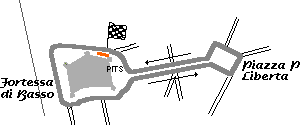
Type: Street circuit Length: 3.307 km (2.055 mi) Location: Near and around Fortezza da Basso (Fortezza di San Giovanni Battista), central Florence. Used: 1937 The course was lined up between the Fortezza di Basso fortress and Piazza Cavour (now: Piazza della Liberta) a little bit north of the city centre. It was 3.307 km long and had the feeling of a park circuit without actually being in a park. Course description: The pits were positioned in a garden on the east side of the fortress and start and finish on the north side. From there the course circled the fortress counter clockwise, first with a fast right curve followed by a slow right angle turn. Following Viale Filippo Strozzi on the south side of the fort it then continued to a S-turn that lead to the wide Viale Regina Margherita (now: Viale Spartaco Lavagnini), which was divided into two lines with wooden cones. Here the drivers had the experience of meeting the opponents coming in opposite direction. The cars followed the right line, circled Piazza Cavour with its victory column before returning along the left line of Viale Regina Margherita. A right hand curve led the cars back to the pit area and then a left hand curve led to the finish line. 1937 GRAN PREMIO DI FIRENZE (Voiturette) CIRCUITO DEL GARDA - Salo (I)
Type: Road course Length: 12.236 km (7.603 mi) Location: Near Saḷ at the western shores of Lake Garda Used: 1921-1927 Course description: Starting in Saḷ the circuit headed south, snaking up the curves of the Zette hill, reaching Cunettone after 4.3 km. Then the course headed north-west past Villa for 4.5 km to Tormini, where the road dropped back to Salo after 3.4 km. For 1927 the grandstand, which had previously been in Saḷ, was now in Cunettone because for the 1927 race the Brescia AC had changed the start from Saḷ to Cunettone. This was all part of the ongoing arguments and conflict between the organizers, the Brescia AC and the Garda Committee including financing. Course lengths: Saḷ (Piazza) to Cunettone 4324 m, Cunettone to Tormini 4516 m and Tormini to Saḷ 3396 m for a total of 12236 m. 1921 CIRCUITO DEL GARDA CIRCUITO DI GELSO BIANCO - Catania (I)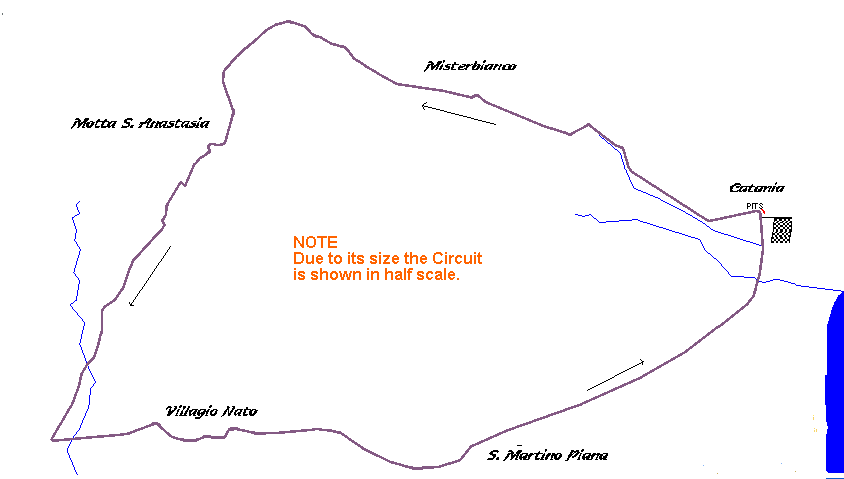
Type: Road course Length: 35 km (21.75 mi) Location: near Catania, Sicily Used: 1927 Circuit description: The circuit, which was no wider than five meters, wound its way over 35 km along a twisting and hilly dirt road course of 150 corners. The start, took place at the Piazza Palestro where the pits and grandstands were located. After rounding the Piazza, the course left Catania along via Palermo and headed uphill in a north westerly direction passing through the town of Misterbianco. From here the course turned south-west to Motta Sant'Anastasia at an altitude of 275 meters. From there the road twisted south for eight kilometers downhill to the dangerous left hand curve of Stazione di Motta S.A. Here the course turned east on flat terrain, then north-east back into the west side of Catania to the finish straight. 1925 COPPA ETNA CIRCUITO DELLA SUPERBA - Génova (I)
Type: Street circuit Length: 3,036 m Location: On the coast some 2 km east of downtown Genoa Used: 1937, (1940) Circuit description: The main grandstand and start were located on Corso Italia between Via Tommaso Campanella and Via Don Giovanni Minzoni, where also a pit with 20 boxes was built. From there the course went anticlockwise on the following streets: Corso Italia, Boccadasse, Via Oreste De Gaspari, Via Tommaso Campanella down to a hairpin behind the grandstand leading back via Via Don Giovanni Minzoni. Then it continued along Via Piero Gobetti, Via Roselli Nello e Carlo, Via Piave and finally along Corso Italia back to the start/finish. 1937 CIRCUITO DELLA SUPERBA CIRCUIT OF LUCCA - Toscana (I)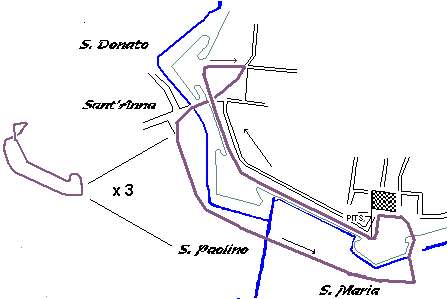
Type: Street circuit Length: 2.35 km (1.46 mi) Location: On and around the southwest town walls Used: 1935-1938 Circuit description: Starting on Via Vittorio Ventio the course continued on top of the city walls westwards from Santa Maria bulwark past Saint Paolino bulwark and over the Vittorio Emanuele gate to Via Saint Paolino, where the course made a double right turn and on Piazzale Boccherini passed under the wall through the Vittorio Emanuele gate. A left turn followed that led to Viale Giosule Carducci, which led the course back eastwards to Santa Maria bulwark where it entered the town center through the San Pietro gate whereafter Via Francesco Carrara led the cars back to the finish line at Via Vittorio Ventio. 1935 COPPA EDDA CIANO/CIRCUIT OF LUCCA CIRCUITO DEI MONTI PELORITANI - Messina (I)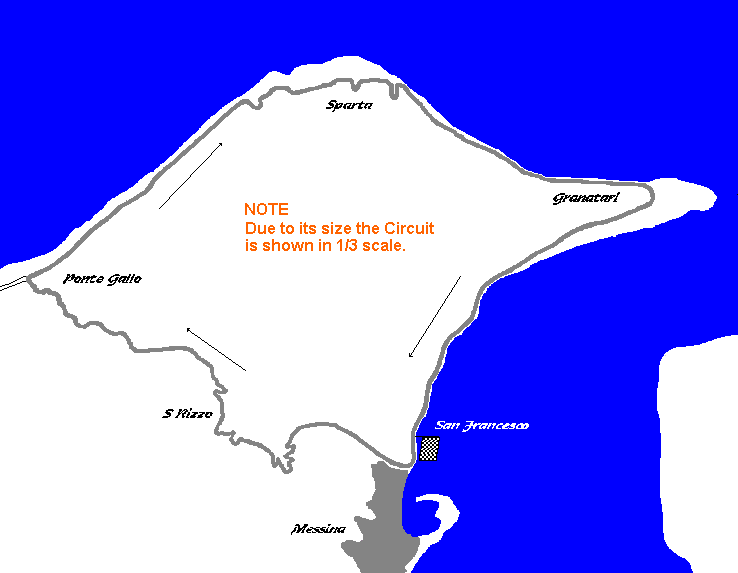
Type: Road Circuit Length: 52 km (32.3 mi) Location: In the mountains south of Messina, Sicily Used: 1925-1928 1925 COPPA VINCI PARCO SEMPIONE - Milano (I)
Type: Park circuit Length: 2.57 km Location: In Sempione park in central Milano, northwest Italy. Used: 1936 CIRCUITO DI MILANO CIRCUITO DI MODENA (I)
Type: Street circuit Length: 3.2 km (1.99 mi) Location: On the streets of central Modena. Used: Starting at the corner Via saragozza/Viale delle Rimembranze the course went clockwise along Viale delle Rimembranze, circled the war memorial anti clockwise, continued along Viale Regina Elena, Viale Nicola Fabrizi, Viale Ludovico Antonio Muratori, Viale Tassoni, Viale Vittorio Veneto and back to Viale delle Rimembranze. 1934 CIRCUITO DI MODENA CIRCUITO DEL MUGELLO (I)Type: Road course Length: 8.170 km (11.29 mi) Location: . Used: 1925 No to be confused with the circuit used 1920-24 and 1927-28. 1925 CIRCUITO DEL MUGELLO CIRCUITO DEL MUGELLO (I)
Type: Road course Length: 64.8 km. From 1928 onwards 61.8 km Location: On the mountain roads north of Mugello valley, between San Piero a Sieve and Firenzuola, Tuscany, between Bologna and Firenze (Florence). Used: 1920-69 This is the circuito vecchio - the old Mugello circuit, not to be confused with the circuito novo - the new Mugello circuit, built in 1974. 1921 CIRCUITO DEL MUGELLO POSILLIPO / CIRCUITO DI NAPOLI (I)
Type: Road course Length: 4.1 km (2.55 mi) Location: Posillipo, west of central Naples on the Italian west coast. Used: 1934 CIRCUITO DI NAPOLI CIRCUITO DI PERUGINA (I)
Type: Road course Length: 16.4 km (10.2 mi) Location: East of Perugia in central Italy Used: 1924 - 1927 The 16.4 km Circuit of Perugia was one of the most beautiful in Italy on the Piano di Marziano route, which passed the Fontivegge Station, San Sisto, Strozzacapponi, Ellera, Olmo and Ferro di Cavallo. Note the spelling: The name of the town was Perugia but the races the Coppa della Perugina. 1925 COPPA DELLA PERUGINA CIRCUITO DEL POZZO - Verona (I)
Type: Road course Length: 12.343 km (7.67 mi) Location: Southeast of Verona, northern Italy Used: 1926-1929 1926 CIRCUITO DEL POZZO CIRCUITO MONTE MARIO - Roma (I)
Type: Street circuit Length: 10.6 km (4.66 mi) Location: West side of the Tiber river, just north of the Vatican. Used: 1926 Used for the 1925 Reale Premio Roma the 10.6 km Monte Mario circuit loacted just north of the Vatican went in clockwise direction along the twisting roads. The start was on Rome's longest straight, the Viale Angelico, heading south and soon turning sharp right into Viale Milizie with another right along Via Trionfale climbing along a narrow winding road up Monte Mario. From there the course wound through numerous half turns downhill along the Cammilluccia. After more right turns into Via Cassia there was a sudden descent through the most difficult right turn near the Milvio Bridge leading into Viale Angelico, where it snaked along the Tiber River through a left bend and a left-right onto the long straight towards the finish. An average speed of only 105 km/h was expected for even the fastest cars on a dry road because the turns were not cambered, often banked the wrong way, and the narrow road seldom exceeded six meters in width. 1925 REALE PREMIO DI ROMA CIRCUITO VALLE GIULIA - Roma (I)
Type: Street circuit Length: 7.5 km (4.66 mi) Location: In the Parioli district of Rome near Tiber river, 4 km north of Forum Romanum. Used: 1926 The second edition of Reale Premio di Roma was held on the Circuito di Valle Giulia. Running clockwise, the start was between the grandstand and the Palazzo delle Belle Arti, then along Viale delle Belle Arti, Lungo Tevere Flaminio, Viale Tiziano and Lungotevere Acqua Acetosa, following into the winding Viale dei Parioli, Viale G. Rossini, Via Aldovrandi and back to Valle Giulia. The narrow course measured 7.5 km and with 40 laps the total distance was 300 km. 1926 REALE PREMIO DI ROMA CIRCUITO DEI PARIOLI - Roma (I)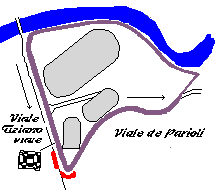
Type: Street circuit Length: 4.2 km (2.61 mi) Location: In the Parioli district of Rome near Tiber river, 4 km north of Forum Romanum. Used: 1927 The third edition of Reale Premio di Roma was held on the Circuito dei Parioli. Running anticlockwise with the start on Viale Tiziano the circuit continued through the left-hand Curva dello Stadio and then into the winding Viale dei Parioli, passing the ippodromo di Villa Glori to the next lefthander, Curva Fonte Acqua Acetosa. From here it went along the Lungotevere dell'Acqua Acetosa to the wide left turn, Curva di Ponte Milvio, and onto the long straight of Viale Tiziano with the finish near the end just after the pits. A complete lap measured 4200 meters and with 100 laps the total race distance was 420 km. For the 1960 Olympic Games there were major changes to the area. The hippodromes and the old stadium were pulled down and replaced by the Olympic village, the Stadio Flaminio football stadium and the Palazzetto dello Sport minor sports palace (basketball, weightlifting). 1927 REALE PREMIO DI ROMA CIRCUITO TRE FONTANE - Roma (I)
Type: Road course Length: 13.05 km Location: Near the Tiber river, 10 km south-west of Forum Romanum Used: 1928-1930 1928 REALE PREMIO DI ROMA LITTORIO - Roma (I)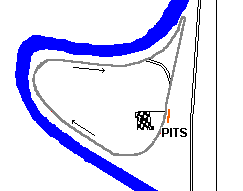
Type: Road circuit with bankings Length: 4 km Location: Around Rome old airfield, near Tiber river. 7 km north of Forum Romanum. Used: 1931-32 In April 1928 a modern airport was opened just outside Rome. Named Aeroporto del Littorio it was the main civilian airport in Italy until World War II. Nowadays it is know as Aeroporto di Roma-Urbe. 1931 in only three months, a 12 meter wide road was been built around the airport, forming the Littorio race track. On May 24, Benito Mussolini inaugurated the very fast circuit, which allowed speeds almost like those at the Avus track. The flat 4 km long macadam course consisted of two long straights connected with two large high banked turns for speeds up to 150 km/h, one fast turn allowing speeds of up to 250 km/h, and one sharp, slow hairpin leading back to start and finish. Ernesto Maserati won the 1931 with a V4 16-cylinder Maserati at an average speed of 152.3 km/h. The next year Luigi Fagioli won with a V5 16-cylinder Maserati at an average speed of 158.7 km/h and settig a fastest lap of 1m26s (167.4 km/h). 1931 REALE PREMIO DI ROMA CIRCUITO DEL SAVIO - Ravenna (I)
Type: Road course Length: 14.5 km Location: South of Ravenna, Emilia-Romagna, 40 km east of Bologna, northern Italy. Used: 1925-27 Circuit description: The start was at the town of Classe from which the circuit led south through Fosso Ghiaia and Casetta, then further on at Campo Aviazione G. Novelli, the course turned west with Savio village further south (on the Google map). Next a turn to the right took a road north to the town of Ponte Nuovo where a sharp right turn headed south back to Classe. In 1926 the triangular route was very slightly extended by 115 meters to 14.5 km. 1925 CIRCUITO DEL SAVIO CIRCUITO DI SAN REMO (I)
Type: Street circuit Length: 1.862 km (1.157 mi) Location: On ste streets of San Remo, 20 km east of Monaco. Used: 1937 1937 CIRCUITO DI SAN REMO PARCO VALENTINO - Torino (I)
Type: Park circuit Length: 4.1 km (1935) 2.92 km (1937) Location: Valentino park, next to river Po in downtown Turin. Used: The 4.088 km long 1935 circuit started at the square in front of the Castello del Valentino and after passing the Botanical garden made a right turn and followed River Po past the Medieval Village (Borgo Medievale) built for the 1884 exposition. From there it continued under the bridgehead of Ponte Isabella and continued to the new Ponte Vittorio Emanuele III bridge. Here it made a turn and went back to Ponte Isabella bridgehead, which it passed this time at bridge level. After passing the Palace of the Festival of Fashion (Mostra della Moda) and a pond, it returned to the start at the front of the castle. For 1937 a new shorter 2.926 km circuit configuartion was used. 1935 GRAN PREMIO DEL VALENTINO CIRCUIT OF VARESE (I)
Type: Road course Length: 3.31 km Location: 1 km north-east of town center of Varese, 40 km north-west of Monza. Used: 1935, 1938 The 1935 event was a sports car race. 1938 CIRCUIT OF VARESE (Voiturette) MILLE MIGLIA (I)Type: Public Road Length: ca 1000 Roman Miles Location: Italy, Brescia-Rome-Brescia 1939 :Held on a course between Tobruk and Tripoli 1940 :Held over a short course around Brescia Used: 1928 - 1957 (-1961) (1982-) 1934 MILLE MIGLIA (Sports car) |
CIRCUIT INDEX
MAIN INDEX
|
© 2021 Leif Snellman - Last updated: 16.09.2021 |